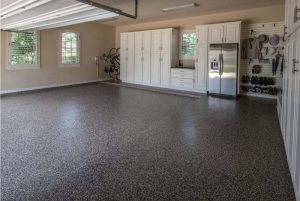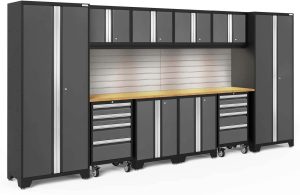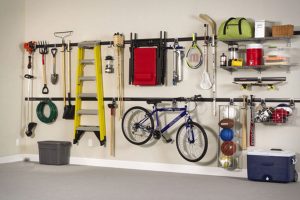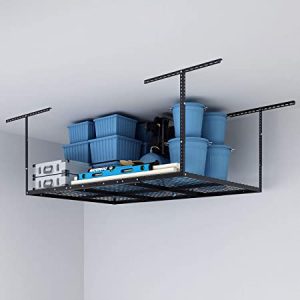The garage is the most valuable part of your home. From parking your car to storing seasonal items, your garage space serves as an integrated storage unit.
Organizing your garage is equally essential because cluttered garage space isn’t suitable for either parking your vehicle or storing goods. Moreover, an unmanaged garage often poses a severe health hazard.
Why Organize Your Garage?
Table of Contents
Most homeowners report that the garage is the place where most severe accidents often take place.
Tripping on the wire, slipping on a wet floor, chemical burn, and injury from small and pointy tools are a few of the common garage-related accidents. Moreover, an unorganized garage poses more danger to unaware kids and pets.
By organizing your garage, you can quickly maximize the usable space to set up a new workshop and keep items in their proper places.
10 Tips to Organize Your Garage
Organizing a garage isn’t about spending money but looking for creative ways to make more space. Start organizing your garage on a budget with these garage storage ideas.
Make a Plan
Start with a plan to organize your garage. Set aside enough time to work on it. Most probably, two days, give or take. The unkempt garage often needs a few days to clear up and organize.
If you’re short on the workforce, consider asking your family member or hiring an expert to assist you. Otherwise, it may turn into an overwhelming task that is likely to be abandoned halfway through.
Always start with small and move to oversized items. Start with removing small items such as paints, car chemicals, loose tools, metal parts, baskets, and then remove power tools, furniture, woodworks, and loose wires.
Categorize the Item
It’s easier to organize garage items when you categorize them. The typical categories include
- Recycling
- Sports gear and recreational items
- Camping gear
- Seasonal (Holiday items)
- Garden gear and tools
- Automotive and vehicle items.
Even when removing garage clutter, you should categorize each item so you’d know what items will go where. The recyclable items will go to the recycling unit, while scraps will go to the dumpster. Donate items that don’t fit any of the categories.
Once you’ve determined the purpose of garage storage, start piling them in the driveway according to their categories. A few cardboard boxes will help you group items. Be sure to label each cardboard, so you don’t mix up things.
Determine the Garage Layout
After removing all items, you’d know how much space you can spare. Decide where each item will go, consider its frequency of use and available space.
The garage wall space is most appropriate for cabinets, pegboard with a magnetic strip, tool bench, and bike rack. Overheard space can be used for ceiling storage and lighting. Similarly, the rear part of the garage is most suited for items that are less frequently used. Consider installing a shelf to store tools, baskets, and seasonal items.
Make sure adding garage cabinets and shelves won’t compromise the parking space.
Use an Epoxy Floor Coating
Before you start putting everything inside, consider redoing your garage floor. The garage floor takes the most amount of traffic, including car parking; hence, it’s a good idea to redo your garage floor for additional strength, resistance against oil and stains, and decor.

Epoxy is one of the best garage flooring options. The mixed compounds of resin and hardeners create a surface that lasts wear and tear. The costs range from $3 to $7 per square foot, depending on the type of epoxy used.
Consider two-part Epoxy floor coating with 100 percent solid for the concrete floors.
Add Garage Cabinets
Start with adding garage cabinets because this is the bulkiest item that will go inside your garage.
Garage cabinets can store almost every possible item, including power tools and machinery; however, the cabinet sizes must be appropriated and budgeted before you start installing them because cabinets are comparatively expensive than other stores.

You can use a storage cabinet for vertical space to store all kinds of items, including household items, car lubricants, leftover paint, tool holders, and gears. You can also combine wall and base cabinets to make a set.
For this, you’d need to determine your garage size. The minimum size of the one-car garage is generally 10x18ft or 12x20ft. You can hardly fit two cabinets on each side of the garage.
Depending on your need and budget, you can install either wood cabinets or metal cabinets. A metal garage cabinet is more durable than wood cabinets, but it only works in garages that don’t have temperature or moisture control. Consider wood to enhance your garage’s look and decor.
Add Some Vertical Storage
If you want to make most of your garage, consider installing vertical storage such as hooks and wall-mounted shelves. This not only saves floor space but also adds flexibility to the garage.

You can add wall shelves as high as you want instead of cabinets that take up a lot of valuable floor space. However, check the weight capacity of shelves to ensure you don’t start storing heavier items that can weigh down the shelves.
Consider a lightweight metal shelf option over particleboard shelves because metal shelves are sturdier.
Hooks and pegboards are great to hang stuff, including garden tools, garden supplies, shovel, bicycle, and sports equipment.
Utilize Overhead Space
Overhead or ceiling space is often an overlooked section in any garage. You should consider using the overhead space if you’re heavy on storage. However, ceiling storage is not appropriate for garages with a low height.

Use ceiling-mounted racks for overhead storage solutions. The stronghold-mounted racks can easily overbear bulky items. Make sure you’re using ceiling joists and metal racks for building garage ceiling storage.
Consider installing a safety net under overhead racks if you’re in an earthquake-prone area such as California.
Overhead space is also great for storing seasonal items like holiday decorations, camping gear, and workshop tools.
Label Everything Inside the Garage
Add labels to help find items quickly. It doesn’t take much time for garage chaos to appear when you start taking and putting items in random places.
Labeling makes everything so much easier to find. Every item will go to its respective place after use. Start with labeling bulky items such as cardboard boxes with heavy tools to the bottom of the rack.
Plastic storage bins are great for storing most garage items. They easily fit inside the cabinet or shelves, and you can easily label them too.
Limit the Amount Your Store
Although the garage holds most of the storage items, it doesn’t mean you start storing everything in it. Though it may be tempting to store everything inside the garage, doing so will make your space cluttered and create occasional organizing issues.
Limit what you store in your garage. Try keeping edible items and clothing out of your garage. Only store items that you will need outside the house, such as gardening tools, lawn tools, cleaning supplies, car lubricants, workshop items, and power tools.
This also means you should avoid keeping usable household items inside your garage. Recycle or donate the items immediately to save space.
Schedule Garage Cleanup and Declutter
Schedule a weekly or biweekly garage cleaning to prevent garage clutters. An unkempt garage quickly starts piling up clutter; hence consider cleaning your garage at least every weekend.
Donate the items you do not need, and throw away unused items, including expired dog food, car lubricant, and empty cardboard.
For regular cleaning of the garage floor, use baking soda and water or detergent and water. Baking soda and water will loosen dirt and grease easily.
You can also consider buying an all-purpose cleaner for your garage.
Conclusion
The tips mentioned above will help keep your garage organized throughout the year. Set an organizing schedule such as quarterly or biannual garage maintenance on your calendar so that you can avoid significant garage overhauling every few years.